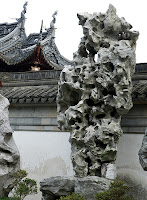In the last article, we have talked about the Bund, one of the famous attractions in Shanghai.In this chapter, we will show you another famous one to you, Yu Yuan, which is an extensive Chinese garden in Shanghai.
Chapter Four
Beauty of Classical Chinese Garden—Yu Yuan Garden
Amidst the gray high rises of Shanghai lies an Oasis of greenery and ancient architecture. --that is Yu Yuan Garden which located next to Old City God’s Temple. In Shanghai, a saying goes as:" Those who have visited Shanghai but missed Yu Yuan Garden cannot claim that they have been to the city."
Yu Yuan Garden is the most famous classical garden with a history of more than 400 years. It is called garden "Yu Yuan", because "Yu" in Chinese means "peace and health"-- a place of peace and comfort in the heart of busy Shanghai.
This grand garden was built by the Pan family, powerful officials of the Ming dynasty. Built between 1559 and 1577 as part of their estate, this typical southern-style garden was destroyed several times and later restored to its former glory. Each pavilion, hall, stone and stream in the garden is expressing the quintessence of South China landscape design from Ming and Qing Dynasty.
There are 40 different scenes in Yu Yuan Garden which divided by dragon walls, wound corridors and beautiful flowers, form a unique picture featuring "one step, one beauty; every step, every beauty."-- the defining feature of the garden is the carefully created sense of space within small confines using narrow lanes, strategically placed partitions and windows that provide frames for portrait views.
The 40 scenic spots scattered throughout the garden are divided into six parts by five boundary walls. The six scenic areas include the Grand Rockery, the Ten Thousand-Flower Pavilion, the Hall of Heralding Spring, the Hall of Jade Magnificence, the Inner Garden, and the Lotus Pool.
- The Grand Rockery
 |
| The Grand Rockery |
- Hall of Heralding Spring
 |
Hall of Heralding Spring
|
- Exquisite Jade Rock
 |
| Exquisite Jade Rock |
- The Inner Garden
 |
| The Inner Garden |
Windows in gently curving walls reveal glimpses of corridors, ponds and streams. Dragons, dogs and elephants adorn eaves and the detail in paving stones and the deliberate placement of trees is extraordinary, yet a sense of the unplanned is somehow retained.
The pavilions and tiny halls house beautifully-carved heavy redwood chairs and tables. The stone garden (in front of the Hall of Jade Magnificence) is rated highly by experts. Even the fish are happy, as shown by the "Happy Fish Veranda" looking out over a delicately arched bridge.
- The Lotus Pool
In front of Yu Yuan Garden, there is a beautiful lotus pool. Across the pond is a zigzag bridge with a pavilion in the middle. The Mid-lade pavilion was rebuilt in 1784 and was later converted into a teahouse. This teahouse is a favorite place for old people, who enjoy chatting with each other over a cup of tea.
Other fun of the teahouse is that it is the ideal place to enjoy the traditional Pingtan --a form of storytelling that traditionally has only one performer. The performer sits on the stage with only a couple of props used to emphasize what he is saying, and tells love tales, or tales of the daring exploits of legendary Chinese figures.
- Old City God Temple
 |
| Shanghai Old City God Temple |
The prosperous Shanghai is decorated with blazing buildings and colorful young ladies. If you want to explore the old Shanghai, Old City God Temple will be the exact place for you to find the 100-year-ago Shanghai here.
In this street, the traditional Chinese buildings are with white walls and black roofs. Moreover, the people, the hanging red lanterns, the ancient memorial arch, all of these form into a picture that describes the old Shanghai.
Besides, there are lots of famous Shanghai local snacks in Chenghuangmiao Old Street. The special dim sum in Lubolang Restaurant, the vegetable Chinese bum in Songyuelou, the Babao rice meal in Songyunlou, and the Nanxiang Chinese bum, all of these can be found in the old street.
-- Actually, although old place of old Shanghai, people can still have new and thrilling ways of entertainment there. Why not wander in Yu Yuan Garden and stroll on the old street of the Old City God Temple to enjoy great fun and wonderful sight-seeing there?


No comments:
Post a Comment
Thanks for your comment and welcome to China!